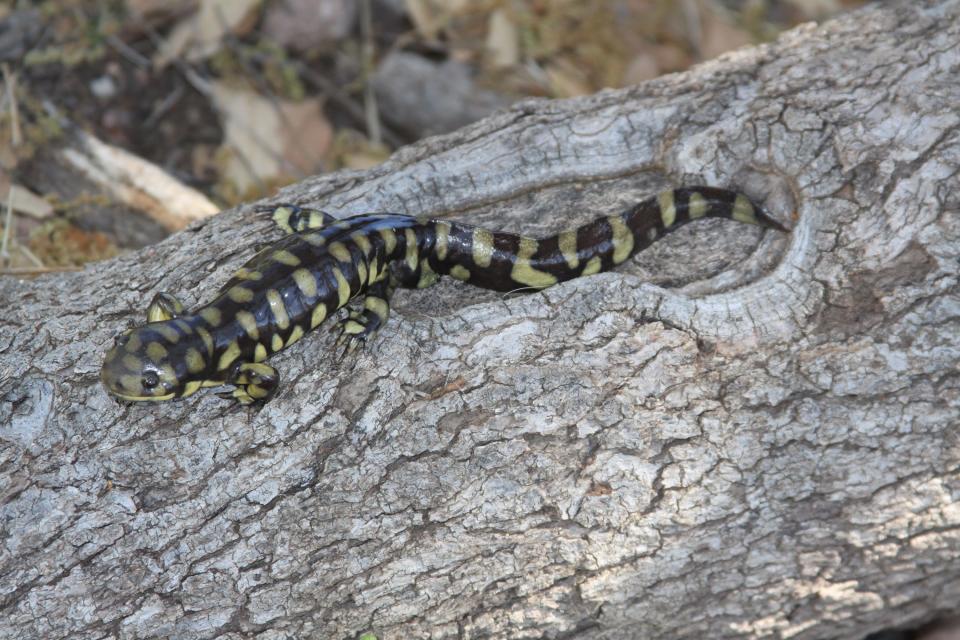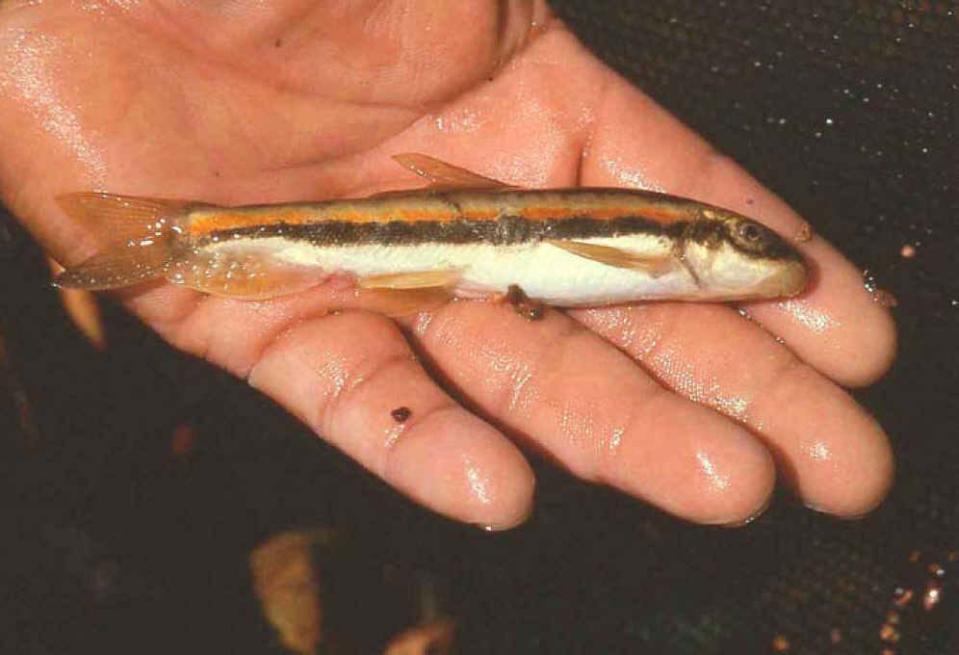Do wildlife agencies shortchange lesser-known species? Activists question priorities
- Oops!Something went wrong.Please try again later.
During the evening hours in the San Rafael Valley of southern Arizona, a yellow and black amphibian crawls out of its aquatic home and searches close to the ground for dinner, possibly worms, snails or small insects.
Although it's one of the largest land-dwelling salamanders in the world, the Sonoran tiger salamander may be hard to spot, not only because of its camouflaged appearance, but because it's so rare, living in a significantly reduced habitat.
For centuries, the salamander inhabited natural pools, ciénegas and springs in southern Arizona. but today, it is found almost exclusively in human-constructed and maintained ponds and cattle tanks. The species, first listed under the Endangered Species Act in 1987, faces vanishing aquatic habitats, invasive species, low genetic diversity and human activity.

Its precarious survival is receiving minimal attention. According to the latest fiscal report released by the U.S. Fish and Wildlife Service, the Sonoran tiger salamander received only $6,000 in federal funding for conservation or management; the year before it received no federal funding, even as some species on the list receive over $1 million annually for conservation from USFWS.
“We know that when effective recovery programs are put into place, in a vast majority of circumstances those succeed and make progress,” said Taylor McKinnon Southwest director at the Center for Biological Diversity. “But some of the less charismatic species are effectively left behind.”
Wildlife agency spends $80 million less, even with the same allocation
Fifty years after the Endangered Species Act was passed, there are still funding issues. McKinnon points to other species, including the Zuni bluehead sucker and the Sonoran mud turtle, that have received little to no funding from the federal government, even though the funds are readily available.
Since these species are not as well known to the public as some carnivores or predatory birds, he says there is a lack of public pressure on Fish and Wildlife and the Department of Interior to properly allocate funding evenly across the species playing field.

According to the report, the agency spent $80 million less in fiscal 2019 than it did the previous year, even though it received the same allocation from Congress.
Some lawmakers, including Rep. Raúl Grijalva, D-Ariz., are trying to free up more money for a wider array of species, but there are wide gaps to close. The Zuni bluehead sucker, a native fish to the Little Colorado and Zuni rivers, received only $1,400 in 2020, though it inhabits less than 90% of its historic range.
Each year, the service develops an annual budget justification that defines goals, objectives and the funding necessary to accomplish them. Once approved, funds are allocated to programs and regions, and monitored to ensure those funds are used as mandated by Congress.
The service has not updated its threatened and endangered species expenditure report since 2020. More than 100 species received less than $10,000 according to the report, including a program for the endangered Northern Aplomado falcon that received $170.
By contrast, the leatherback sea turtle received more than $4 million during 2020.
USFWS declined to comment on the budget and didn’t respond to other questions.
“The public has an affinity for charismatic species," McKinnon said. "The American bald eagle was an endangered species act success story. But the Fish and Wildlife Service's duties pertain to all of the species that are at risk of extinction.”
Species most at risk: Jaguars, leopard frogs, condors: Here are some of Arizona's most imperiled species
Threats mount for species, even as funding remains stagnant
In 1973, then-President Richard Nixon signed the Endangered Species Act, which at the time was hailed as the “most comprehensive legislation for the preservation of endangered species enacted by any nation.” The act provided a framework for conservation and management strategies for threatened and endangered species.
The act has been paramount in keeping thousands of species from going extinct. Famous beneficiaries of this legislation include the bald eagle, peregrine falcon and the Florida manatee.
The act establishes protections for fish, wildlife and plants that are listed as threatened or endangered. It allows for development and implementation of management plans, research, and protection and restoration of habitat. It relies on interagency support including state-level agencies, like Arizona Game and Fish, though a vast majority of funding comes from federal resources handed down each year from Congress.
Supporters say the act is more important than ever, as human activity continues to alter or fragment habitat for species on and off the list. Increased climatic threats such as wildfires and changes in precipitation and temperatures put already imperiled species at greater risk for extinction.
“Endangered species are endangered because of various threats have impacted them and caused declines, and in most cases climate change is magnifying those threats,” McKinnon said.
The humpback chub is one of those species. It was first documented in the Lower Colorado River Basin in the Grand Canyon in the 1940s and the upper Colorado River Basin in the 1970s.
The construction of large dams and the introduction of non-native fish have isolated the populations of chub. McKinnon said hydrologic changes caused by drought and warmer temperatures are adding stress for the imperiled species.
“An already difficult circumstance, with the rapid onset of climate change and regional aridification has made a bad situation worse,” said McKinnon. “And it did so faster than anyone expected it to happen.”
Still, the Fish and Wildlife Service downlisted the humpback chub from endangered to threatened in 2021, concluding that it was no longer in immediate danger of extinction. Activists say such success stories show the value of the Endangered Species Act.
Success story: Here's what to know about a proposal to remove the Apache trout from the threatened list
Lawmaker says every species plays a vital role
Other less charismatic species need protection as well, environmental activists say. The service recently announced it was proposing protections for an imperiled southwestern spring snail.
The Quitobaquito tryonia is a small freshwater snail found mainly in Quitobaquito Springs along the Arizona-Mexico border. The service determined the snail to be at risk of extinction because of spring modification, and the effects of drought and climate change. The number of known populations has already been reduced by 50% because of these factors.
While these less charismatic creatures may sometimes be overlooked, their significance on the ecosystem cannot be understated. Since all animals are part of the food chain, an imbalance of one species may affect another down the line.

“Each species, if you look into their natural history, are a remarkable miracle of nature and evolution,” said McKinnon. “But some of those species just aren’t known or appreciated.”
The center believes Congress has significantly underfunded the Endangered Species Act for decades and gives the agency only a small fraction of what is needed to fulfill the duties of the act. The most recent spending bill advancing in the U.S. House of Representatives cuts the agency’s budget by 14%.
A 2016 study found that Congress only provided about 3.5% of the estimated funding Fish and Wildlife Service scientists say is needed to recover species.
The center wants Congress to fully fund the agency’s endangered species program by providing at least $800 million per year. This level of funding would ensure every listed species receives a minimum of $50,000 a year for their recovery.
Earlier this year, some members of Congress pushed for more wildlife conservation funding. Rep. Raúl Grijalva, D-Ariz., along with Sen. Richard Blumenthal, D-Conn., reintroduced the Extinction Prevention Act in May to provide additional funding for some of the country’s most imperiled species.
“The biodiversity crisis demands immediate and meaningful action to safeguard wildlife while we still have the chance,” said Grijalva. “Every species, regardless of its popularity or charisma, plays a vital role in the functioning of a natural ecosystem.
The wildlife service has set aside new funding in recent months. In July the agency earmarked $5.1 million for at-risk species including freshwater mussels, desert fish, butterflies and plants in Hawaii and the Pacific Islands, which were included in the proposed Extinction Prevention Act. The legislation originally asked for $5 million for each of the four groups annually.
The funding, from the Inflation Reduction Act, will be used to fund conservation projects related to restoration, management, conservation and education.
On Thursday, the Interior Department said it would spend $2.3 million through the Cooperative Endangered Species Conservation Fund to support land acquisition for six imperiled species in Arizona.
The money will support the acquisition of 1,272 acres toward conservation efforts for the Gila topminnow, ocelot, Chiricahua leopard frog, jaguar, Huachuca water-umbel and southwestern willow flycatcher.
The funding will also help preserve the largest springs in the Sonoita Creek watershed, including Cottonwood and Monkey Springs, which provide important riparian and aquatic habitats for these species. The funding is authorized by the Endangered Species Act, with additional funding coming from the Land and Water Conservation Fund.
Despite the Endangered Species Act's overwhelming success, politicians have aimed to cut funding. The law has been criticized for placing restrictions on industries such as logging, mining and oil and gas development. Members of Congress and these industries have argued that the act places the burden on operations.
In July, House Republicans voted to strip protections for two species covered by the act, the lesser prairie chicken and the northern long-eared bat, citing government overreach.
But research conducted by Defenders of Wildlife found that in more than 88,000 consultations on federal actions, no projects in these industries were stopped or extensively altered.
The act also details permitting provisions that can allow for economic activity in these industries to continue, if efforts to minimize and mitigate the impact on imperiled species are made.
Jake Frederico covers environment issues for The Arizona Republic and azcentral. Send tips or questions to jake.frederico@arizonarepublic.com.
Environmental coverage on azcentral.com and in The Arizona Republic is supported by a grant from the Nina Mason Pulliam Charitable Trust. Sign up for AZ Climate, our weekly environment newsletter, and follow The Republic environmental reporting team at environment.azcentral.com and @azcenvironment on Facebook, Twitter and Instagram.
You can support environmental journalism in Arizona by subscribing to azcentral today.
This article originally appeared on Arizona Republic: Less-popular species need more help from Endangered Species Act funds

